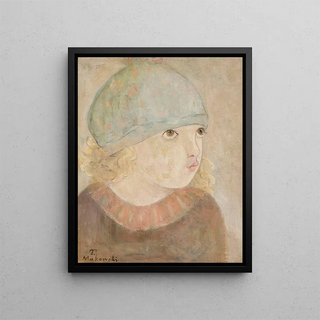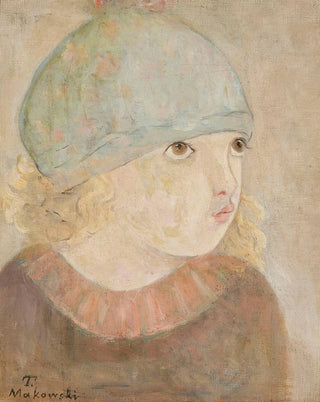Art print | Girl with Blue Hat - Tadeusz Makowski


View from behind

Frame (optional)
In the world of art, some works manage to capture the essence of human emotion with such intensity that they transcend time and space. "Fille au chapeau bleu" by Tadeusz Makowski is one of these creations that, through its apparent simplicity, evokes an unsuspected depth. This piece, depicting a young girl wearing a blue hat, invites the viewer to immerse themselves in a universe of vibrant colors and delicate shapes. The artist, through his skillful play with light and shadow, manages to breathe life and movement into his subject, transforming an ordinary scene into an unforgettable visual experience.
Style and uniqueness of the work
Tadeusz Makowski's style is distinguished by its unique fusion of impressionism and symbolism. In "Fille au chapeau bleu," fluid brushstrokes and pastel shades intertwine to create an atmosphere that is both gentle and melancholic. The figure of the young girl, with her delicate face and expressive features, seems to emerge from a dream, as if she were both present and distant. The blue hat, shining against the darker background, becomes a symbol of freedom and carefree spirit. Every detail, from the movement of the hair to the luminous reflections on the fabric, testifies to the artist's technical mastery. Makowski knows how to capture the fleeting moment, the one where beauty manifests in its purest form, thus offering the viewer an invitation to contemplate life's fragility.
The artist and his influence
Tadeusz Makowski, born in Poland in 1882, established himself on the European artistic scene in the early 20th century. His career, marked by various influences, ranging from Fauvism to Cubism, reflects a constant quest for innovation and personal expression. By settling in Paris, he was in contact with many renowned artists, which enriched his creative approach. His work is often imbued with nostalgia for childhood, a theme dear to his heart, which is reflected in "Fille au chapeau bleu." Makowski managed to create a

Matte finish

View from behind

Frame (optional)
In the world of art, some works manage to capture the essence of human emotion with such intensity that they transcend time and space. "Fille au chapeau bleu" by Tadeusz Makowski is one of these creations that, through its apparent simplicity, evokes an unsuspected depth. This piece, depicting a young girl wearing a blue hat, invites the viewer to immerse themselves in a universe of vibrant colors and delicate shapes. The artist, through his skillful play with light and shadow, manages to breathe life and movement into his subject, transforming an ordinary scene into an unforgettable visual experience.
Style and uniqueness of the work
Tadeusz Makowski's style is distinguished by its unique fusion of impressionism and symbolism. In "Fille au chapeau bleu," fluid brushstrokes and pastel shades intertwine to create an atmosphere that is both gentle and melancholic. The figure of the young girl, with her delicate face and expressive features, seems to emerge from a dream, as if she were both present and distant. The blue hat, shining against the darker background, becomes a symbol of freedom and carefree spirit. Every detail, from the movement of the hair to the luminous reflections on the fabric, testifies to the artist's technical mastery. Makowski knows how to capture the fleeting moment, the one where beauty manifests in its purest form, thus offering the viewer an invitation to contemplate life's fragility.
The artist and his influence
Tadeusz Makowski, born in Poland in 1882, established himself on the European artistic scene in the early 20th century. His career, marked by various influences, ranging from Fauvism to Cubism, reflects a constant quest for innovation and personal expression. By settling in Paris, he was in contact with many renowned artists, which enriched his creative approach. His work is often imbued with nostalgia for childhood, a theme dear to his heart, which is reflected in "Fille au chapeau bleu." Makowski managed to create a






